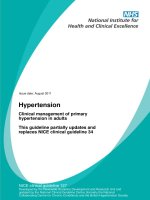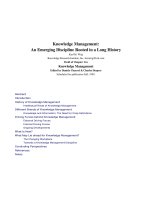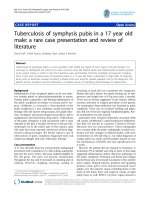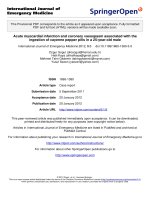Clinical management of hyper matured cataract in a labrador dog
Bạn đang xem bản rút gọn của tài liệu. Xem và tải ngay bản đầy đủ của tài liệu tại đây (205.59 KB, 6 trang )
Int.J.Curr.Microbiol.App.Sci (2020) 9(7): 1217-1222
International Journal of Current Microbiology and Applied Sciences
ISSN: 2319-7706 Volume 9 Number 7 (2020)
Journal homepage:
Case Study
/>
Clinical Management of Hyper Matured Cataract in a Labrador Dog
Benudhar Mahanand1, Jayakrushna Das1*, Aditya P. Acharya2 and Ritun Patra3
1
Department of Veterinary Surgery and Radiology, 2Department of Veterinary Pathology,
3
Department of Veterinary Anatomy, College of Veterinary Science & Animal Husbandry,
Orissa University of Agriculture and Technology, Bhubaneswar-751003 (Odisha), India
*Corresponding author
ABSTRACT
Keywords
Cataract, IOL, Lens
and Dog
Article Info
Accepted:
11 June 2020
Available Online:
10 July 2020
A 5 years old female Labrador retriever dog was presented for treatment of
blindness. From history it was known that the animal progressively developed
gradual loss of vision since last one year to complete blindness. Upon physical and
clinicalexamination, it revealed bilateralcataract and was confirmed by
ultrasonography examination and referred for cataract surgery by small incision
cataract surgery (SICS) technique. After removal of cataractous lens one rigid
polymethylmethacrylate (PMMA) 41 Diopter (D) intra-ocular lens (IOL) was
implanted and the animal regained normal vision after 7days.
surgical removal of affected lens under
general anesthesia.
Introduction
Eye is one of the most important sense organ
of body. Among different parts of eye, the
lens is an exceptionally living ocular tissue,
which is usually well defined, transparent
biconvex biological objective. The lens when
loses its transparency and power of
accommodation, the image formation on
fovea of retina is greatly hampered and
animal suffers from blindness. Cataract is the
opacity of lens and its capsule (Orfi, 2017).
The primary cataract occurs due to diabetes,
chemicals, radiation, electricity and trauma
whereas secondary cataract occurs due to
uveitis, progressive retinal atrophy and
glaucoma (Bath and Dua, 2006). The
preferred choice of treatment of cataract is
Case history and examination
One female Labrador retriever dog of 5 years
age, weighing 33 kg body weight, was
presented for treatment of blindness in both
the eyes. From history, it was known that the
animal progressively lost its vision since one
year. The colorations of interior of eye had
changed from haziness to lime white. The
animal was examined under daylight and
inside dark room. Apart from blindness,
therewere no remarkable abnormalities on
both the eyes. On physical exam, there was no
pathological condition of eyes except bilateral
cataract. The menace test (0), catoptrics test
1217
Int.J.Curr.Microbiol.App.Sci (2020) 9(7): 1217-1222
(0), pupillary light reflex (+) and tapetal
reflex (0) showed negative while maze test
(+++) and obstacle test (+++) were positive
on 0 to 3 scale basis of measurement. On
clinical examination with Schirmer’s tear test,
it was 14 mm/min in right and 15 mm/min on
left eye and intra-ocular pressure (IOP) by
digital tonopen28 mm Hg in right and 26
mm/min on left eye. Then it was examined by
portable hand held slit lamp bio-microscope
in dim light. The corneal layers of both the
eyes showed clear and normal consistency,
but both the lens were totally opaque and no
part of light beam was passing through the
opaque lens. No part of posterior segment was
visible
with
the
aid
of
indirect
ophthalmoscope/ fundus camera. So neither
optic disc nor tapetum was seen. On
ultrasonography, the case was diagnosed as a
case of bilateralhyper matured cataract. On
haemato-biochemical exam it was seen that
parameters such asHb, TEC, TLC, DC, CT,
BT, and serum glucose, total protein,
albumin, globulin, BUN and creatinine values
were within normal range. With the consent
of owner it was decided to go for cataract
surgery of one eye (right eye)by small
incision cataract surgery (SICS).
Surgical technique
Four drops of Tropicamide eye drop
(Auromide®, Aurolab India) was instilled on
right eye as mydriatic for 3 times at 30
minutes
interval
prior
to
surgery.
Intramuscular injection of meloxicam
(Melonex®, Intas Pharmaceuticals, India) @
0.4 mg/kg body weight (BWT) and injection
Ceftriaxone Sodium + Sulbactam (MonocefSB® 500 mg, Aristo Pharmaceuticals,
India)@ 15 mg/kg BWT was administered
before anaesthesia. As preanaesthetics,
injection Glycopyrolate (Pyrolate®, Neon
Laboratories
Limited)
was
given
subcutaneously @ 0.01mg/kg BWT 20
minutes
before
induction.
Injection
butorphanol (Butodol®, Neon Laboratories
Limited) @ 0.2 mg/kg BWT and midazolam
(Mezolam, Neon Laboratories Limited) @ 0.3
mg/kg BWT were given intravenously
followed by Injection Propofol (Neorof®,
Neon Laboratories Limited) @4mg/kg BWT
I/V for induction and maintained by
Propofol@ 1mg/kg BWT.
The operative procedure was conducted as per
SICS technique. For this the animal was kept
on left lateral recumbency with head resting
over cloth roll to the position of operation for
right eye. Oxygen connecting tube was
attached to the nostril. The site around eye
ball was applied with povid one iodine five
times on different directions. The fornices
were cleaned with povidone iodine dipped
sterile buds. The sterile drape having window
was covered over the head and body parts
keeping window slit at eye ball. Then another
disposable sterile drape was covered over the
first drape. Both the eye lids were opened and
fixed using appropriate sterile eye speculum.
Topical anesthetic eye drop of proparacaine
(Aurocaine®, Aurolab, India) was instilled on
eye.
At 10 to 12 o’clock position of limbus, the
bulbar conjunctiva was incised and reflected.
The bulbar bleeding was controlled by using
bipolar electro-cautery. Then 2 mm away
from limbal margin a semilunar incision was
given extending from 10-12 o’clock position
using BP handle (No.3) fitted with 15 number
blade. Then using crescent, one tunnel was
prepared through the previously made
incision by giglis movement. Then holding
the limbus by Lim’s forceps, keratome was
taken through the crescent made tunnel and
incised the cornea. Then at 9 o’ clock position
one port was made on limbal junction using
MVR blade (Myringovitreoretinal).Simcoe’s
2 way cannula was attached to the anterior
chamber (AC) and irrigated using Ringer’s
Lactate solution (RL). Then at 3’o clock
1218
Int.J.Curr.Microbiol.App.Sci (2020) 9(7): 1217-1222
position another port was made on cornea just
above the limbus. Throughout the surgical
procedure RL was sprinkled over cornea to
keep moist.
At 3 o’clock port one air bubble was injected
below cornea and at the same time Trypan
blue solution was sprinkled over anterior
capsule of lens by a cannulated syringe.
Through 3 o’clock port the previously
prepared 26 gauge capsulorrhexis needle was
introduced and the anterior capsule was
wounded and reflected. Through flushing the
excised capsular material was removed using
flushing syringe. The site was thoroughly
flushed using hydro-dissection cannula fitted
with 10 ml syringe having RL so as to
dislodge the lens from capsular bag. The
cataractous lens was over matured and was
there like chalky materials. Hence these white
chalky materials were irrigated, flushed and
aspirated
using
Simcoes’2
way
cannula.Repeated flushing was done so as to
remove the remnants of dissolute lens
materials. Viscoelastic substance was pushed
into AC and flushed using RL. Then
polymethylmethacrylate (PMMA) intra ocular
lens (IOL) (Aurolens®, Aurolab, India) of 41
Diopter was placed into the capsular bag.
Using Dialer, the haptic of IOL was adjusted
inside the lens capsular bag properly so as to
remain in correct position. Then the AC was
thoroughly irrigated and flushed to remove
the remnants of viscoelastic substance. Then
one large air bubble was pushed to the AC so
as to remain elevating the cornea in its normal
shape.
The 3 and 9 o’clock ports were sealed by
hydration method using RL in pressure
through cannulated syringe. The 10 to 12 o’
clock tunnel was sutured using 10-0 nylon.
The injured conjunctiva was dragged and
covered at the incised site and was plugged
using bipolar electrocautery. Injection
dexamethasone (Dexona®, Zydus-Cadila,
India) 0.2 ml was injected into subconjunctiva at lower bulbar region. Povidone
iodine eye drops were instilled. Both the
eyelids were closed and padding was applied.
The owner was advised to instill eye drops of
Ofolxacin and prednisolone 5 times a day and
the prednisone should be used with tapering
doses as advised with use of Elizabethan
collar (E-collar). It was applied with used
socks on its paws in order to prevent
scratching and soiling the operative site.
After 5 days of operation the tarsorrhaphy
sutures were removed. The operated eye was
slightly congested but the animal was able to
visualize the surrounding objects. Eye was
cleaned with luke warm saline and povidone
eye drop instilled. The owner was advised to
continue the eye drops regularly with use of
Elizabethan collar for another week.
Results and Discussion
The dog recovered well and regained its
vision after a week. It was able to resume
activities like movement, running, taking
food, identifying the articles, responding to
call from a distance henceforth. For doing
cataract surgery, Young, et al., (1991) had
used anaesthetic regimes using propofol as an
induction agent to thiopentone because of
reduced recovery time during anesthetic
period. It was further reported that the globe
can be physically moved to a central position
for intraocular surgery by using stay sutures
or clips. In this case we have used eye
speculum of appropriate size and cloth was
kept below the head to keep in position.
Gilger (2003) performed intracapsular/
extracapsular lens extraction in dogs to treat
cataract by dorsal limbal incision. GarciaSanchez et al., (2005) treated a case of
bilateral senile cataract in an 11 year old
female
miniature
poodle
by
phacoemulsification with intraocular lens
1219
Int.J.Curr.Microbiol.App.Sci (2020) 9(7): 1217-1222
implantation. Ramani, et al., (2005)
performed lens extraction and intraocular lens
implantation
without
any
major
complications.
Jorge
(2017)
had
performed
phacoemulsification
for
removal
of
cataractous lens in 15 dogs and implanted
intra ocular lenses. They reported that, all the
eyes were visual 90 days after surgery.
Ganesan and Ramani (2018) implanted a
suitable 37–41 diopter multifocal plate haptic
single-piece hydrophilic 2-hydroxy ethyl
methacrylate (HEMA) IOL through the
extended (3.5–4.0 mm) main incision into the
capsular bag in twelve eyes after
phacoemulsification. In our case, the poly
methyl methacrylate (PMMA) IOL of 41 D
was used for implantation in doing the SICS
as it was not suitable for phacoemulsification
owing to its hypermaturity.
Fig.1 Labrador Retriever, showing Bilateral cataract (OU)
Fig.2 Showing Color Doppler Ultrasonography of Cataract
Fig.3 Showing Limbal incision on bulbar conjunctiva
1220
Int.J.Curr.Microbiol.App.Sci (2020) 9(7): 1217-1222
Fig.4 Showing eye after irrigation of anterior chamber after IOL implantation
Nasisse, et al., (1990) reported that poor
postoperative vision was caused mostly by
inadequate pupil size and clarity, which were
threatened consistently by miotic effects of
postoperative uveitis. Klein et al., (2011)
reported vision retention in 90% of eyes with
a median of 302 days of follow up in 103
dogs or 179 eyes. Guimarães, et al., (2017)
studied
the
surgical
outcome
and
postoperative complications in 182 dogs. The
presence of intraocular lens did not have any
detrimental effect on postoperative outcome
or
the
frequency
of
postoperative
complication.
Gaiddon et al., (2000) reported mild
inflammation, characterized by congestion of
episcleral vessels, corneal edema and protein
within the anterior chamber after surgery for
cataract and intraocular lens implantation,
which resolved by day 8. In the present case
there was only slight inflammation with
bulbar congestion, which reduced after
removal of tarsorrhaphy sutures and
instillation of eye drops.
References
Bath,C.S and Dua, K. 2006. Treatment of
cataract in dogs.Indian Journal of
Veterinary Medicine.26. (1): 77-79.
Guimaraes, T.G., Honsho, C.S., Mamede,
F.V., Dias, F.G.G., Anjos, D.S.,
Pereira, L.F., Ricordi, I. and Jorge,
A.T., 2017. Retrospective study of
ocular
complication
following
phacoemulsification with intraocular
acrylic
lens
implantation
in
dogs. Arquivo Brasileiro de Medicina
Veterinária e Zootecnia, 69(4), 915920.
Jorge,
F.
V.
2017. Avaliação
do
errorefrativoem cãespseudo fáquicos,
afáquicos e fáquicos com recurso a
retinoscopia de luzemfenda (Doctoral
dissertation, Universidade de Lisboa,
Faculdade de MedicinaVeterinária).
Gaiddon,J. A., Lallement, P.E., Peiffer, R. L.
Jr.
2000.Journal
of
American
Veterinary
Medical
Association.
216(6):875-877.
Ganesan, S. andRamani, C. 2018.Ocular
ultrasonographic
evaluation
of
cataractous and pseudophakic eyes in
dogs.Turkish Journal of Veterinary and
Animal Sciences.42: 611-616.
Garcia, Sanchez.,Whitley, A. R. D., Brooks,
D. E., Trigo, F. andPinon, A. 2005.
Ahmed valve implantation to control
intractable
glaucoma
after
Phacoemulsification and intraocular
lens implantation in a dog. Veterinary
Ophthalmology.8(2):139-144.
Gilger,B.C. 2003. Lens.In textbook of Small
Animal Surgery.IIIrdedition. Saunders,
Philadelphia: 1402-1418.
1221
Int.J.Curr.Microbiol.App.Sci (2020) 9(7): 1217-1222
Klein, H.E., Krohne, S.G., Moore, G.E. et al.
2011.Postoperative
complications
and
visual
outcomes
of
phacoemulsification in 103 dogs (179
eyes):
2006-2008.
Veterinary
Ophthalmology .14:114–120.
Naisse, M.P., Davidson, M.G., English, R.V.,
Roberts, S.M.
and Newman,
H.C.1990.Neodymium: YAG Laser
treatment of Lens Extraction – Induced
Pupillary Opacification in dogs. Journal
of
American
Animal
Hospital
Association.26: 275-281.
Ofri, R. 2017. Diseases of the Lens. Slatter's
Fundamentals
of
Veterinary
Ophthalmology E-Book, 306.
Ramani, C., Ameerjan,K. and David,A. 2005.
Cataract extraction and intraocular lens
implantation Part I: Clinical evaluation
of the instrumentation and operative
techniques.
Indian
Veterinary
Journal.82: 153-157.
Young, S. S., Barnett, K.C. and Taylor, P.M.
1991. Anaesthetic regimes for cataract
removal in the dog.Journal of Small
Animal Practice.32:236-240.
How to cite this article:
Benudhar Mahanand, Jayakrushna Das, Aditya P. Acharya and Ritun Patra. 2020. Clinical
Management of Hyper Matured Cataract in a Labrador Dog. Int.J.Curr.Microbiol.App.Sci.
9(07): 1217-1222. doi: />
1222









